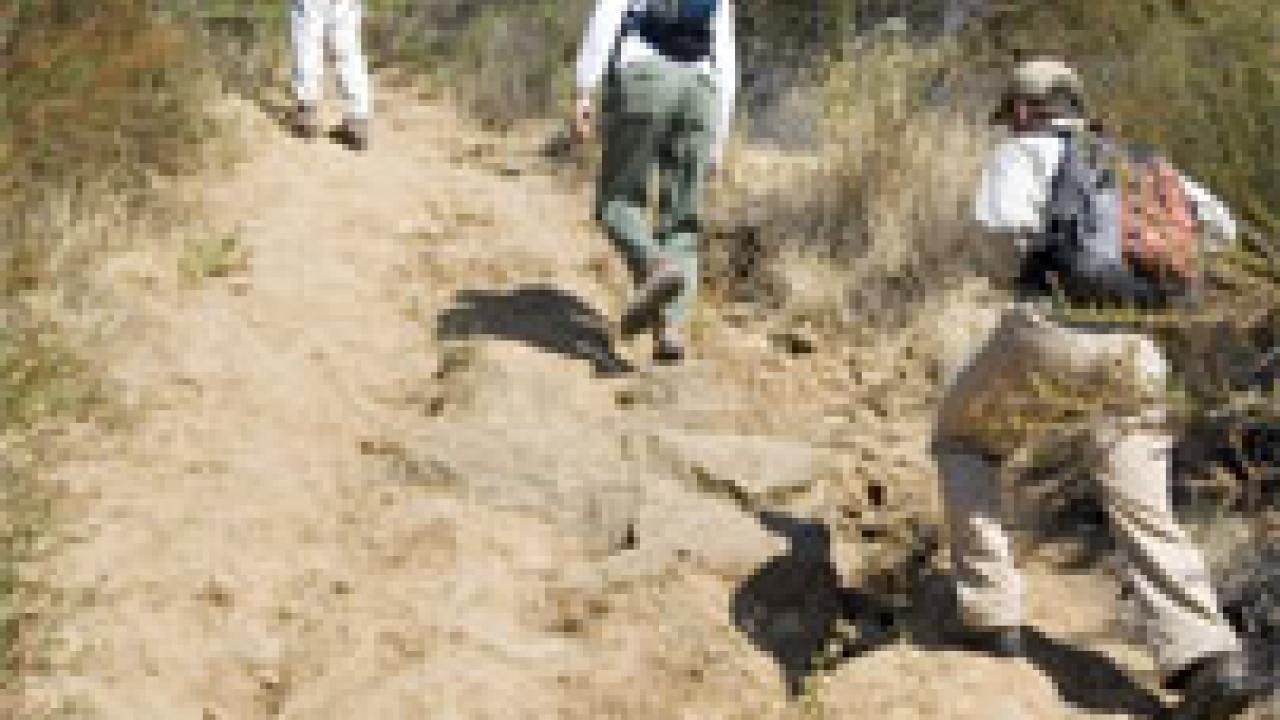Usually at this time of year, seasonal rainstorms turn a steep section of the popular Loop Trail in Stebbins Cold Canyon Natural Reserve from a rugged walking path into a deep, muddy trench. Already an impediment, the steep section becomes dangerous and unpleasant for visitors during the winter months, and important plants and animals living downhill in Putah Creek get smothered in sediment.
But this year will be different. The UC Davis-based managers of the 576-acre University of California reserve recently purchased the privately owned land where the steep section lies, and already work crews are up on the hillside rerouting the trail.
The erosion-prone section is being eliminated and restored to a natural condition. In its place is a new trail route with graceful, gently sloping switchbacks traversing the hillside to carry hikers upward without doubling as rain gutters.
Fixing the five-mile Loop Trail, which leads to spectacular views of Lake Berryessa and the Coast Ranges, has been a longtime goal for reserve manager Virginia "Shorty" Boucher.
Her next objective is to raise an endowment of $500,000 for the reserve's popular Guides Program, which is run by Winters resident Jeff Falyn and offers educational outings for people of many interests and ages.
Boucher will name the endowment in honor of the late, renowned evolutionary biologist G. Ledyard Stebbins, for whom the reserve is named.
"Stebbins Cold Canyon Natural Reserve is unusual because, unlike most university reserves, it is open to the public," Boucher said. "It has become a tremendously popular place for people to go for recreation. Last year, while we served 700 educators and students, which are our primary clients, we also served more than 7,000 members of the public."
The new land acquisition consists of 59.1 acres in two parcels (making the reserve now nearly 640 acres), purchased from an individual with a $46,000 grant from the California Coastal Conservancy.
The new trail was designed by UC Davis Natural Reserves project coordinator Shane Waddell and Stebbins reserve steward Kenny Walker. Materials are being paid for by funds allocated for the original Loop Trail construction. The construction labor is being provided by fire crews from the California Department of Forestry and Fire Protection's Delta Conservation Camp.
To support the endowment, contact Boucher at (530) 752-6949 or vlboucher@ucdavis.edu.
In addition to supporting the endowment, Boucher said, there are other ways for members of the public to get involved with the reserve:
- To see the progress on the Loop Trail, take an independent walk any time; the reserve is open daily from dawn to dusk. Access is free. For a trail map, e-mail Jeff Falyn at jfalyn@ucdavis.edu or visit the Stebbins site online at http://nrs.ucdavis.edu/stebbins.html.
- To experience the reserve at the winter solstice, join a free guided walk on Saturday, Dec. 23, from 10 a.m. to 1 p.m. This is the last guided walk and program in the fall/winter series; programs resume in March. To reserve a spot on this walk (which will not include the Loop Trail), or to receive the 2007 schedule of programs, which range from hikes for toddlers to stargazing, send an e-mail request to Jeff Falyn at jfalyn@ucdavis.edu.
- To learn to create and lead your own guided walks in the reserve, join the next guide training session, which begins in January at the reserve. Information: Jeff Falyn at jfalyn@ucdavis.edu.
- To help care for and sustain the physical reserve, join the Preserve the Reserve program. Participants work in the reserve throughout the year, planting native grasses, shrubs and trees, removing invasive plants, and doing trail construction -- including some of the continuing work on the Loop Trail. Information: Jeff Falyn at jfalyn@ucdavis.edu.
The UC Natural Reserve System is the largest and most diverse set of university-owned-and-operated reserves in the world. Its 33 reserves include examples of nearly every major ecosystem in the state. These reserves provide secure sites for long-term environmental research, education and public outreach. They enable monitoring of environmental health, and provide a baseline for ecosystem restoration, in the context of California's rapidly growing population and the changing global environment.
Six reserves are administered by the Davis campus, through the John Muir Institute of the Environment. The six are: Stebbins Cold Canyon Reserve, Quail Ridge Reserve, Donald and Sylvia McLaughlin Reserve, Bodega Marine Reserve, Eagle Lake Field Station and Jepson Prairie Reserve.
[Editors: Color, high-resolution photographs are available by e-mail. They show the Loop Trail before and after reconstruction, and the views of Lake Berryessa from the top of the trail. Contact Sylvia Wright, below.]
Media Resources
Virginia Boucher, John Muir Institute of the Environment, (530) 752-6949, vlboucher@ucdavis.edu
